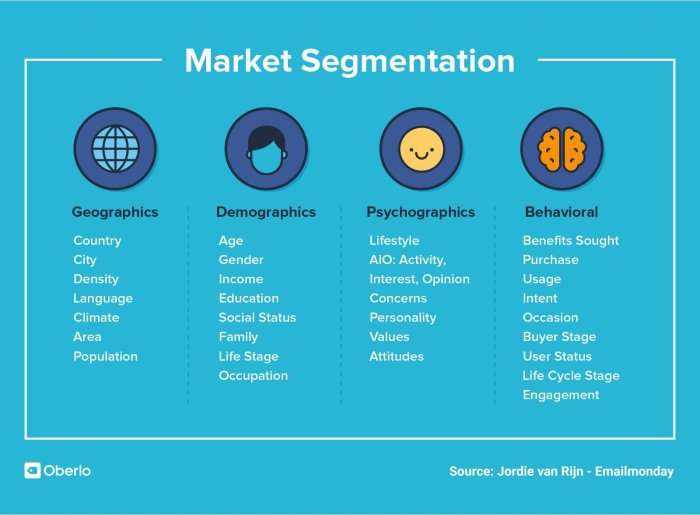Understanding Customer Segmentation sets the stage for unlocking the secrets to effective marketing strategies, diving into the various methods and factors that influence how businesses connect with their target audience in a whole new way.
From dissecting different types of customer segmentation to exploring the implementation process, this topic is your backstage pass to revolutionizing your marketing game.
Customer Segmentation Overview: Understanding Customer Segmentation
Customer segmentation is the process of dividing a market into distinct groups of customers based on specific characteristics, behaviors, or demographics. This allows businesses to tailor their marketing strategies and offerings to better meet the needs and preferences of each segment.
Understanding customer segmentation is crucial for businesses as it helps them identify their target audience more effectively. By analyzing customer data and behavior, companies can create personalized marketing campaigns, products, and services that resonate with different segments, leading to increased customer satisfaction and loyalty.
Benefits of Customer Segmentation
- Improved Customer Targeting: By dividing customers into segments, businesses can target their marketing efforts to specific groups with relevant messaging and offers.
- Increased Sales and Revenue: Understanding customer segmentation can lead to higher conversion rates and customer retention, ultimately driving sales and revenue growth.
- Enhanced Customer Experience: Tailoring products and services to different customer segments can result in a more personalized and satisfying experience for customers.
Examples of Customer Segmentation
- Demographic Segmentation: Dividing customers based on age, gender, income, or education level to target specific groups with tailored marketing campaigns.
- Behavioral Segmentation: Analyzing customer behavior such as purchase history, browsing patterns, and preferences to create personalized recommendations and promotions.
- Psychographic Segmentation: Understanding customers’ lifestyles, values, and interests to develop targeted messaging that resonates with different psychographic segments.
Types of Customer Segmentation

Customer segmentation is crucial for businesses to target their marketing efforts effectively. There are various types of customer segmentation strategies that companies can utilize to better understand their customers and tailor their marketing campaigns accordingly.
Demographic Segmentation
Demographic segmentation involves categorizing customers based on factors such as age, gender, income, education, occupation, and family size. This type of segmentation helps businesses target specific groups of customers who share similar characteristics. For example, a company selling luxury skincare products may target customers aged 35-50 with a higher income level.
Psychographic Segmentation
Psychographic segmentation focuses on customers’ lifestyles, values, interests, and personality traits. By understanding customers’ psychographics, businesses can create more personalized marketing messages that resonate with their target audience. For instance, a fitness apparel company may target customers who value health and wellness and enjoy outdoor activities.
Behavioral Segmentation, Understanding Customer Segmentation
Behavioral segmentation divides customers based on their purchasing behavior, such as buying frequency, brand loyalty, usage rate, and benefits sought. This type of segmentation helps businesses identify the most profitable customers and tailor their marketing strategies to encourage repeat purchases. An online streaming service may target customers who frequently binge-watch TV shows and movies.
Geographic Segmentation
Geographic segmentation involves segmenting customers based on their location, such as country, region, city, or climate. Businesses use geographic segmentation to customize their marketing efforts based on local preferences, cultural differences, or climate conditions. For example, a fast-food chain may offer different menu items in regions with diverse culinary preferences.
Factors Influencing Customer Segmentation
Age, gender, income, lifestyle, and purchasing behavior are key factors that influence how customers are segmented. These factors play a crucial role in shaping marketing strategies and customer engagement for businesses. Let’s dive deeper into how these factors impact customer segmentation.
Age
Age is a significant factor in customer segmentation as different age groups have varying preferences, habits, and needs. For example, younger customers may be more tech-savvy and interested in innovative products, while older customers might prioritize reliability and customer service.
Gender
Gender is another important factor that can impact customer segmentation. Marketers often tailor their messaging and product offerings based on gender preferences. For instance, a cosmetics company may create different marketing campaigns for male and female customers.
Income
Income level plays a crucial role in customer segmentation as it determines purchasing power. Customers with higher incomes may be willing to spend more on luxury products or services, while those with lower incomes might prioritize affordability and value.
Lifestyle
Lifestyle choices and behaviors also influence customer segmentation. Customers with active lifestyles may be interested in fitness products, while those with a focus on sustainability may prefer eco-friendly options. Businesses often target specific lifestyle segments with tailored offerings.
Purchasing Behavior
Understanding customers’ purchasing behavior is essential for effective segmentation. Factors such as frequency of purchases, preferred channels, and brand loyalty can help businesses create targeted marketing strategies. By analyzing purchasing behavior, businesses can personalize their approach and enhance customer engagement.
Implementing Customer Segmentation

Implementing a customer segmentation strategy involves several key steps to effectively divide your customer base and tailor your marketing efforts accordingly.
Steps for Implementing Customer Segmentation
- Identify Segmentation Variables: Determine the criteria you will use to segment your customers, such as demographics, behavior, or psychographics.
- Collect Data: Gather relevant data on your customers through surveys, purchase history, website analytics, and other sources.
- Analyze Data: Use data analysis tools to identify patterns and segments within your customer base.
- Create Customer Profiles: Develop detailed profiles for each customer segment based on their characteristics and behaviors.
- Implement Marketing Strategies: Tailor your marketing campaigns and messaging to target each customer segment effectively.
Best Practices for Collecting Data
- Utilize Multiple Data Sources: Combine data from various sources to get a comprehensive view of your customers.
- Ensure Data Accuracy: Regularly update and clean your data to maintain its accuracy and relevance.
- Respect Customer Privacy: Obtain consent from customers before collecting and using their data for segmentation purposes.
Personalizing Marketing Efforts
- Use Segmented Email Campaigns: Send targeted emails to different customer segments based on their preferences and behaviors.
- Customize Website Content: Display personalized content on your website based on the customer segment visiting the site.
- Offer Tailored Promotions: Create special offers and discounts that are relevant to each customer segment’s needs and interests.





